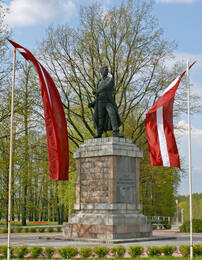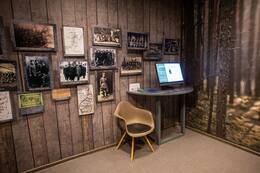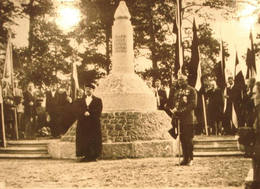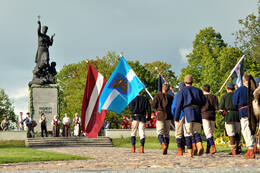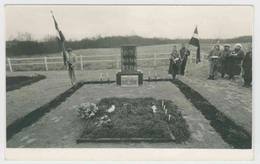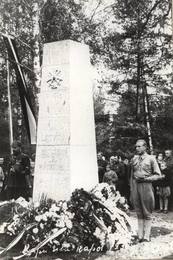Partisanide tegevus Põhja-Latgales
I Maailmasõda ja iseseisvumine
Esimesed Latgale partisanide rünnakud Nõukogude Läti armeele algasid 1919. aasta märtsis. Mais asutati Kupravas, Rugājas ja mujal mitu suurt, umbes 30-mehelist sõjaväeosa. 29. ja 30. mail ründasid partisanide üksused Põhja-Vidzemest läbi Balvi tulnud Nõukogude Läti armee osi. 15. juunil õnnestus bolševike relvarongil vallutada Kuprava jaam, 21. juunil üritati sooritada kordusrünnak Balvi jaama suunas. Partisanid piirasid koos umbes 100 Eesti sõduriga rongi sisse ja sundisid Pitalova suunas taanduma. 1919. aasta suvel vallutasid partisanid Eesti sõdurite toel Liepna ja Balvi.
5. juulil 1919 otsustasid partisanirühmade esindajad Balvis toimunud koosolekul ühineda üheks rügemendiks ja 7. juulil formeeriti partisanirühmadest vanemleitnant Jānis Vīndedža (1892-) juhtimisel Latgale partisanide polk. 1926). Esialgu oli partisanide rügemendil neli kaunistust. 13. juulist läks polk Kurzeme diviisi ülema alluvusse. 28.-30. Juulis toimusid kaklused Baltinava lähedal ja Punduri jaamas, Vilaka vallutati. Pärast lahinguid Stompakai ja Susāja juures moodustati kohalikest partisanidest rügemendi 5. kompanii. 9. augustil moodustati Liepna partisanide diviisist 6. kompanii, mis hõivas Liepna 22. septembril. 1919. aasta oktoobris kasvas partisanide rügement 2000-meheliseks, mistõttu see reorganiseeriti ja moodustas kolm pataljoni 8 ornamendiga ning 9. kompanii moodustas neljanda pataljoni. 4. oktoobril määrati rügemendi ülemaks kolonelleitnant Jānis Skujiņš (1897-1942), 16. oktoobril hõivas rügemendi 2. pataljon Nostrovi ja Stompakuse. 7.-9. Novembris asus Punaarmee vasturünnakule ja saavutas tagasi oktoobris kaotatud positsioonid. 1920. aasta jaanuaris oli rügemendis 49 ohvitseri ja 2400 võitlejat, kellel olid ka kuulipildujad. Rügement osales 1920. aasta jaanuaris ja veebruaris Põhja-Latgale vabastamisoperatsioonides.
Vabadussõja ajal kaotas Latgale partisanide polk 145 hukkunut. 40 rügemendi sõdurit autasustati Lāčplēsi sõjaordeniga.
14. augustil 1938 avati Balvis Brīvībase ja Partizānu tänavate ristmikul monument Latgale partisanide rügemendi langenud sõduritele "Valvepartisan".
Rohkem teabeallikaid
Jānis Skujiņš. Latgale partisanide polk. Raamat: Latgale vabastamise 15. aastapäeva mälestuseks. 1920-1935 Rezekne, 1935, lk 32-33; ka: http://www.periodika.lv/periodika2-viewer/view/index-dev.html#panel:pp|väljaanne:/g_001_0307061306|artikkel:DIVL259|lehekülg:32|väljaande tüüp:määratlemata
Latgale partisanide polk. Vikipeedia. https://en.wikipedia.org/wiki/Latgales_partiz%C4%81nu_pulks
Seotud ajajoon
Seotud objektid
Monument Latgale partisanide rügemendi 1919-1920 langenud sõduritele
Latgale partisanide rügemendile pühendatud monument.
Läti Vabadussõja (1919-1920) ajaloos moodustati "rohelistest" rügementidest juba 1918. aasta lõpus Latgale partisanide polk, mille häll oli kunagi endise Balvi rajooni territooriumil.
Monument avati esmakordselt 14. augustil 1938 kindral Jānis Balodise osavõtul. Monumendi autor on kunstnik Kārlis Jansons.
1940. aastal hävitasid kommunistid monumendi, pärast nõukogude võimu kehtestamist otsustas Abrene rajooni täitevkomitee 1941. aasta kevadel monumendi lammutada, kuid partisani kujutis maeti Balva miilitsa õuele. Saksa ajal monument taastati, kuid Punaarmee tagasi tulles lõhuti monument teist korda maha, viidi minema ja hävitati. Kui Läti taasiseseisvus, kogusid balvenlased annetusi Latgale partisanide monumendi taastamiseks. 11. novembril 1993 avati Balvosel kunstnik Kārļis Jansonsi poja Andrej Jansonsi restaureeritud monument.
Näitus "Ziemeļlatgale vabadusvõitluses" Balvu maakonna muuseumis
Näitus võimaldab heita pilgu Läti iseseisvuse ajalukku Põhja-Latgale vaatevinklist. Milline on meiepoolsete inimeste panus, kuidas meie vanaisad kaasasid võitlusse Läti ühise asja eest, millised on nende saatused, kuidas säilib nende mälestus? Nendele ja teistele küsimustele leiab vastused läti, vene ja inglise keeles.
Põhja-Latgale vabastamisoperatsioon, mida nimetatakse ka Viļakas-Jaunlatgale hõivamisoperatsiooniks, oli osa Latgale vabastusrünnaku operatsioonist, mille Läti relvajõud Läti vabadusvõitluse ajal läbi viisid. Selle eesmärk oli hõivata Latgale põhjaosa ja läbi lõigata Pihkva-Daugavpilsi raudteeliin, et takistada Nõukogude Vene vägede lisaüksuste saabumist Eesti rindelt ja Venemaa seest. Olulisemad lahingud toimusid 9.-20. jaanuaril 1920, mil saavutati kontroll Pitalovast (Abrene) Kārsavasse viiva raudteeliini üle.
Jaškovis Läti vabastamislahingutes hukkunud sõdurite mälestussammas
Teelõik Viļaka – Vientuļi (P35) on vasakul pool teed, Jaškova haua kabeli juures.
Vabadussõjas langenud Läti ja Eesti sõdurite mälestussammas.
Skulptor Kārlis Zemdega 1920. aastal Jaškovis vabadusvõitluses langenud sõdurite mälestuseks loodud monument avati esmakordselt 22. septembril 1935 1929. aastal rajatud vendade Viļaka haudadel.
Vabadusvõitlus Punaarmee vastu Viļakase rajoonis algas Läti armee ja Latgale partisanide rügemendi rünnakuga 9. jaanuaril 1920. aastal. Sellel osalesid ka Eesti sõdurid. Viļak vabastati juba 9. jaanuaril, kuid lahingud temast ida pool kestsid veel mitu päeva. Nii enne kui ka pärast Vilakase vabastamist maeti langenud sõdurid erinevatesse kohalikele elanikele teadaolevatesse paikadesse. Läti riigi stabiliseerudes hakkas Viļakas mõtlema vendade ühishaudade rajamisele. Juba 18. novembrist 1923, pärast praost P.Apšinīksi peetud pidulikku jumalateenistust katoliku kirikus, suundus suur rongkäik äsja moodustatud vendade matmispaika mäel, nn Jaškovi. Viļaka ümbrus. Peagi rajati monumendi vundament, algas monumendi annetuste kogumine. Langenud sõdurite haudade väljaselgitamine võttis aega, alles 3. novembril 1929 toimus ümbermatmine tulevastesse vendade haudadesse. Neisse maeti Viļakase ümbruses langenud 31 Läti ja 14 Eesti sõdurit, 1935. aastal oli monument valmis ja 22. septembril pühitseti see pidulikult sisse.
Sõjaeelsetel Läti iseseisvusaastatel olid kõik Viļaka kihelkonna tähtsamad riiklikud sündmused seotud vennashaudade ja selle monumendiga.
Mälestis hävis sõjajärgsetel nõukogude võimu aastatel, kuid selle graniidist osad, kuigi kahjustatud, säilisid. Monument taastati 11. novembril 1990 – Lāčpleši päeval.
Monument "Ühtne Läti".
Latgale vabastamise monument (rahvasuus tuntud kui "Latgales Māra") on Rēzekne kõige äratuntavam sümbol. Pühendatud 1920. aastal Läti vabadusvõitluses osalejatele ning kehastab ideed Läti riigi vabadusest ja ühtsusest. Monument avati 1939. aastal. (kunstnik L. Tomasickis, skulptor K. Jansons), selle pronksist skulptuurikompositsioon koosneb: ketitõmbajast, mis sümboliseerib Latgale kangelaslike poegade poolt võõrvõimude üle võidetud vabadust, tema kõrval põlvitav tüdruk kroonib vabastajat pärjaga. tammelehed ja mõlema figuuri kohal – rahvustütar, kelle käes ta hoiab ülestõstetud kuldset risti – sümboliseerides usku ja rahulolu taastatud vabaduse üle.
1940. aasta monument lammutati 1943. aastal see taastati, kuid 1950. a valitsev võim hävitas selle. 1992. aastal kerkis monument tänu rahva annetatud vahenditele taas täies hiilguses Vabadusallee mäele (skulptor A. Jansons).
Mälestuskivi rohelistele partisanidele
See asub Ergļis Parka ja Saulese tänava nurgal raudteeviadukti lähedal.
23. mail 1919 ründasid rohelised partisanid Ergli kesklinnas suurmeeste Vezumniki kolonni. Lahing kestis kaks tundi ja partisanid said 78 hobust ja palju vankreid vintpüsside ja muu kaubaga. Lahingus hukkus neli partisani, üks sai haavata. Kokku võitles maakonnas partisanide ridades 61 meest, kellest kuus hukkus.
21. mail 1939 avati Kotkaste külas 121. Kotkasrügemendi mälestuskivi kohas, kus 23. mail 1919 langesid rohelised partisanid Jānis Andriksons, Andrejs Bumbers, Kārlis Baņgieris ja Jānis Gūts.
Nõukogude okupatsiooni ajal lammutati Parka ja Saulese tänava ristmikul asuv mälestussilt. See restaureeriti ja paigaldati uuesti 22. aprillil 1989. aastal.
Vilaka muuseum
Viļaka muuseum tegutseb kahes hoones – 1913. aastal ehitatud katoliku kogudusemajas, mis on linna oluline kultuuripärandi objekt, ja muuseumi teises hoones – endises kaputsiinide kloostris, mille keldrid on tihedalt seotud Stom pakis toimunud rahvusliku partisaniliikumisega ja Nõukogude Tšekaaga. Kohalike elanike mälestuste kohaselt hoiti ja piinati nendes keldrites inimesi. Vanas muuseumihoones on mitu näitust, millest üks on pühendatud 1920. aasta vabadusvõitlustele Põhja-Latgales ja teine Teise maailmasõja sündmustele – juudi holokaustile Viļakas ja teabele maha lastud perede kohta. Lisateavet iga perekonna kohta saab tema aadressi järgi.
Näitust täiendab teave Stompaki rahvusliku partisaniliikumise kohta – mitmesugused tunnistused, fotod ja esemed. Külastajad saavad tutvuda Viļaka ja selle ümbruse sõjalise pärandi objektidega, näiteks Jaškovas asuva Vabadusvõitlejate monumendiga, mis lammutati nõukogude ajal ja taastati 1990. aastal, ning Lāčplēsise ordeni kavaleritele pühendatud steeliga. Muuseumi näitusesse on integreeritud Teise maailmasõja lennukite heli, kuna Viļaka lähedal asus Saksa Luftwaffe lennuväli. Muuseum pakub võimalust näha mälestusi Teise maailmasõja sündmustest Viļakas ning saada teavet Saksa sõjavangide laagri kohta Račis.
Seotud lood
Põhja-Latgale vabastamine bolševike käest
1. detsembril 1918 tungisid Punaarmee osad, mis põhinesid Punapüssi üksustel, Läti territooriumile. Oma kodude, perede, põlismaakondade kaitsmiseks ja hirmu eest põgenemiseks võtsid Balvi ümbruse mehed relvad ja läksid metsa ning tekkisid esimesed "rohelised" rühmad. 1919. aasta kevadel, kui mobilisatsioon välja kuulutati, ei lubatud paljusid Balvi kandi mehi Nõukogude Läti armeesse sõdida ja nad liitusid "roheliste" rühmitustega. Moodustati Balvi, Silakrogi, Rugāji, Teteru-Dūrupe ja Liepna rühmad. Balvi ümbruses aktiviseerus "roheliste" rühmade tegevus 1919. aasta märtsis.





